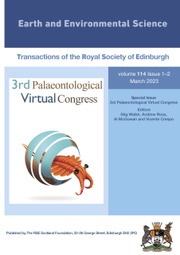Article contents
VIII.—On the Elevation of the Boiling Points of Aqueous Solutions of Electrolytes
Published online by Cambridge University Press: 06 July 2012
Extract
It has been known for a length of time that the presence of a non-volatile substance diminishes the vapour pressure of the solvent in which it is placed, and as the boiling point of a solvent or a solution is the temperature at which the vapour pressure is just equal to, or overcomes the pressure of the atmosphere, it follows that a solution has a higher boiling point than the solvent. Amongst the first experimenters in this field were Faraday, Legrand, Griffiths, and Raoult. TO Raoult we owe much for his development of the subject.
- Type
- Research Article
- Information
- Earth and Environmental Science Transactions of The Royal Society of Edinburgh , Volume 45 , Issue 1 , 1906 , pp. 193 - 240
- Copyright
- Copyright © Royal Society of Edinburgh 1906
References
page 193 note * Ann. Chim. Phys., 20, 324Google Scholar.
page 193 note ‡ Pogg. Ann., 2, 227Google Scholar.
page 193 note ∥ Ztschr.phys. Chemie, 3, 603 (1889)Google Scholar, 4, 532 (1889).
page 193 note ‡ Ann. Chim. Phys., 59, 423Google Scholar.
page 193 note § Compt. Bend., 103, 1125Google Scholar.
page 193 note ¶ Ztschr. phys. Chemie, 21, 245 (1896)Google Scholar, 15, 656 (1894).
page 194 note * Am. Chem. Journ., 17, 507Google Scholar.
page 194 note ‡ Ber. der Chem. Ges., 31, 458CrossRefGoogle Scholar.
page 194 note ∥ Am. Chem. Journ., 19, 581CrossRefGoogle Scholar, also 31, 340 (1904).
page 194 note ** Journ. Chem. Soc., 73, 509 (1898)Google Scholar.
page 194 note ‡‡ Physical Chemical Methods (Jones), p. 35.
page 194 note ‡ Journ. Chem. Soc. (London), 61, 989Google Scholar.
page 194 note § Ztschr. phys. Chemie, 39, 409 (1902)Google Scholar.
page 194 note ¶ Ztschr. phys. Chemie, 40, 208 (1902)Google Scholar.
page 194 note ‡ Physical Chemical Methods (Jones), p. 31.
page 196 note * B. A. Report on the Present State of our Knowledge of Electrolysis and Electro-chemistry (1893).
page 197 note * Zeit. für phys. Chem., 5, 250 (1890)Google Scholar.
page 197 note ‡ B. A. Report on the Present State of our Knowleige of Electrolysis and Electro-chemistry (1893).
page 197 note ‡ Phil. Mag. (6), 3, 487 (1902)CrossRefGoogle Scholar.
page 197 note ∥ Wied. Ann., 41, 259 (1890)Google Scholar.
page 197 note § Zeit. für phys. Chem., 25, 497Google Scholar.
page 197 note ¶ Acc. Sci. Torino, 40, Nos. 2 and 3, pp. 155, 163 (1904–5).
page 198 note * Practical Methods for determining Molecular Weights, translated by Jones and King, p. 189.
page 198 note ‡ Journal of the Chemical Society, 73, 502 (1898)CrossRefGoogle Scholar.
page 198 note ‡ Zeit. für phys. Chemie, 39, 420Google Scholar.
page 199 note * Proc. Roy. Soc. Edin., 25, 960, 1905Google Scholar.
page 199 note ‡ Zeit.für phys. Chemie, 40, 185 (1902)Google Scholar.
page 199 note ‡ Ibid.
page 199 note § Ibid.
page 204 note * Ber. der Chem. Ges., 31, 471 (1898)Google Scholar; Practical Methods for determining Molecular Weights, Biltz, translated by Jones and King, p. 189 (1899); Zeit. für Anorg. Chemie, 17, pp. 435 and 450 (1898)Google Scholar; Sakurai, , Journal of Chem. Soc., 61, 989CrossRefGoogle Scholar; Walker, and Lumsden, , Journal of Chem. Soc., 73, 509 (1898)Google Scholar.
page 207 note * International atomic weights, 1904.
page 208 note * Phil. Mag. (6), 3, 487, 1902CrossRefGoogle Scholar.
page 211 note * Wied. Annal., 10, 326 (1880)Google Scholar.
page 211 note ‡ Zeit. phys. Chemie, 21, 297Google Scholar.
page 218 note * In a paper read recently at the Royal Society, Edinburgh, Dr Gibson has pointed out a somewhat similar result.
page 218 note ‡ Am. Chem. Journ., vol. xxxiv., No. 4, 373 (1905)Google Scholar.
page 225 note * See page 226.
page 226 note * Phil. Mag., 1900, p. 505Google Scholar.
page 226 note ‡ Zeit. phys. Chemie, 40, 204 (1902)Google Scholar.
page 228 note * See Cane Sugar.
page 229 note * Page 227.
page 230 note * Zeil. phys. Chemie, 40, 204 (1902)Google Scholar.
page 230 note § Am. Chem. Jour., 31, 355 (1904)Google Scholar.
page 230 note ‡ Am, Chem. Jour., 31, 325 (1904)Google Scholar.
page 230 note ∥ Am. Chem. Jour., 31, 356 (1904)Google Scholar.
page 230 note ‡ Page 226.
page 230 note ¶ Am. Chem. Jour., 33, 583 (1905)Google Scholar.
page 231 note * Zeit. phys. Chemie, 43, 539–564 (1903)Google Scholar.
page 231 naote ‡ Rev. Phys. 12, 220 (1901)Google Scholar.
page 231 note ‡ Jour. Chem. Soc., Oct. 1905.
page 235 note * Göttinger Nachrichten, p. 86 (1900, 1903).
- 3
- Cited by


